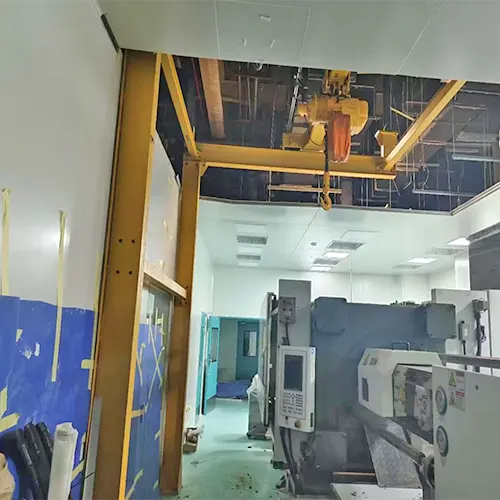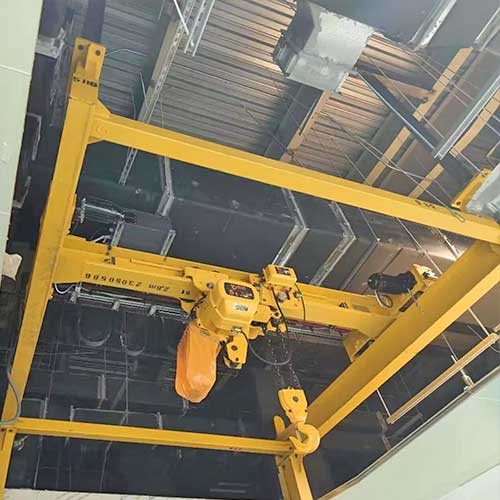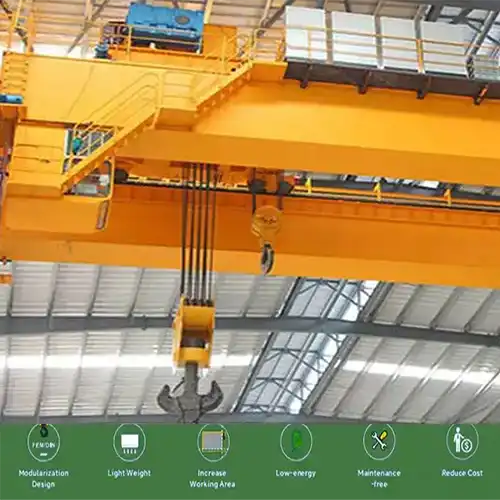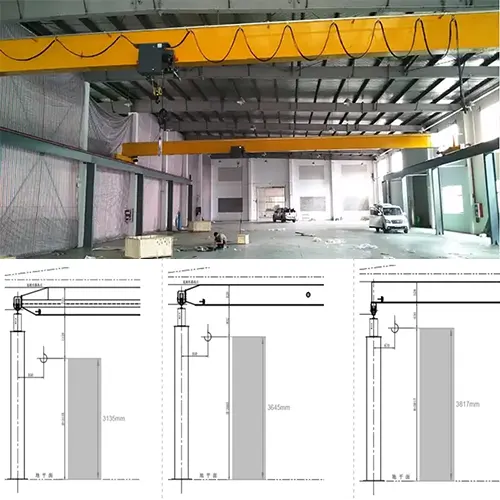Buying Guide for Small Shop Bridge Cranes, Good Price Small Crane
Small Shop Bridge Crane for Sale. Buying tips on small bridge cranes to select right small shop bridge crane for your needs, custom workshop crane.
Category: Bridge Crane
Your Trusted Small Bridge Crane Manufacturer & Supplier
Buying Guide for Small Shop Bridge Cranes
Good Price Small Bridge Crane 1 Ton, 2 Ton, 3 Ton, 4 Ton, 5 Ton for Sale
Small Shop Bridge Crane for Sale. Buying tips on small bridge cranes to select right small shop bridge crane for your needs, custom workshop crane.
Explore essential features, types, and expert tips to select the perfect small shop bridge crane for your workshop needs.
A small shop bridge crane is a practical and versatile tool designed to help lift and move heavy objects within a workshop. Typically mounted on tracks, this type of crane features a horizontal beam that moves along the length of the workshop, allowing operators to easily transport items from one area to another. These cranes are particularly useful in small spaces where traditional forklifts may not fit or be practical.
Selecting the right bridge crane for your small workshop is crucial. An improperly chosen crane can lead to inefficient operations, increased safety risks, and even potential damage to both the crane and the materials being lifted. Factors such as load capacity, lift height, and span must be carefully considered to ensure that the crane meets your specific needs. A suitable bridge crane can improve your workflow, enhance productivity, and create a safer working environment.
This buying guide aims to provide clear and valuable information to help you understand small shop bridge cranes better. It will cover the essential features to look for, different types available, and practical tips for assessing your workshop's requirements. By following this guide, you will be better prepared to make an informed choice, ensuring that your investment in a bridge crane adds significant value to your operations.
Basics of Small Shop Bridge Cranes
A small shop bridge crane is a type of overhead lifting device that uses a horizontal beam, known as a bridge, to move heavy loads across a defined space. This crane is typically mounted on two parallel tracks, allowing it to traverse back and forth over a specific area of the workshop. The bridge is equipped with a hoist that can lift and lower objects, making it a versatile tool for handling various loads.
The design of a small shop bridge crane is straightforward yet effective. The key components include the bridge, end trucks that support the bridge and allow it to move, and the hoist that lifts the load. Depending on the model, these cranes can be operated manually or powered by electric motors. Many designs also incorporate safety features, such as limit switches to prevent over-travel and emergency stops, ensuring safe operation within the workshop.
The functionality of a small shop bridge crane is what makes it indispensable in many environments. It allows for precise placement of heavy items, reducing the risk of injury to workers and damage to products. By optimizing vertical and horizontal movement, these cranes can efficiently transport materials without taking up valuable floor space.
Common Applications
Small shop bridge cranes are widely used across various industries due to their efficiency and adaptability. Here are some common applications:
- Manufacturing Facilities: In manufacturing settings, these cranes are essential for moving heavy components, such as metal sheets, machinery parts, and assembly units. They streamline the production process by enabling quick and easy transport of materials to and from workstations.
- Automotive Shops: In automotive repair and assembly shops, small bridge cranes help lift engines, transmissions, and other heavy parts. Their ability to handle substantial weight makes them ideal for tasks that require precision and safety.
- Construction Sites: Small shop bridge cranes are often used in construction for lifting building materials, such as beams and concrete blocks. Their flexibility allows for effective movement within tight spaces.
- Warehousing: In warehouses, these cranes can facilitate the loading and unloading of goods, making inventory management more efficient. They can help transport heavy pallets and equipment safely without the need for larger, more cumbersome machinery.
- Repair and Maintenance: In workshops focused on repairs, these cranes assist technicians in lifting and maneuvering heavy equipment, tools, and parts. This capability enhances workflow and reduces manual lifting injuries.
Overall, the adaptability of small shop bridge cranes makes them valuable assets in any workshop or industrial setting where heavy lifting is required.
Key Features to Consider
Load Capacity
One of the most critical factors to consider when choosing a small shop bridge crane is its load capacity. This refers to the maximum weight the crane can safely lift and move. To determine the appropriate load capacity for your specific applications, start by evaluating the heaviest items you plan to handle. Consider not only the weight of the items themselves but also any additional factors, such as the weight of attachments or any load-sharing accessories. It's essential to choose a crane with a load capacity that exceeds your maximum expected weight to ensure safety and efficiency.
Selecting a crane with too low of a capacity can lead to operational failures, while an excessively high capacity may increase costs without providing additional benefits. It's also wise to factor in the future needs of your workshop, as your load requirements may change over time.
Span and Lift Height
The span and lift height of a small shop bridge crane are crucial dimensions that directly impact its functionality in your workspace.
- Span Length: This refers to the distance between the two support tracks on which the crane moves. The correct span ensures that the crane can cover the necessary area of your workshop, allowing it to reach all workstations or storage areas. Measure your workspace carefully to choose a span that optimizes movement without obstructing other operations.
- Lift Height: This is the maximum vertical distance the crane can raise a load. The lift height should accommodate the tallest items you need to lift and any overhead clearance required for safe operation. Consider ceiling height and potential obstacles when determining your ideal lift height.
Properly assessing span and lift height will ensure that your small shop bridge crane operates effectively within the constraints of your workshop, enhancing productivity while minimizing risks.
Power Source
When selecting a small shop bridge crane, you'll also need to decide between electric and manual operation. Each power source has its pros and cons:
- Electric Cranes: These cranes are powered by electric motors, offering efficient operation with minimal manual effort. They are suitable for heavier loads and frequent use, providing quick lifting and lowering capabilities. However, they may require a dedicated power supply and regular maintenance to ensure proper function.
- Manual Cranes: Manual bridge cranes rely on hand-operated mechanisms, such as hand cranks or lever systems, to lift loads. They are generally more affordable and do not require electricity, making them a good choice for smaller shops with less frequent lifting needs. However, they can be labor-intensive and may not be suitable for very heavy loads.
Evaluating your operational needs, frequency of use, and budget will help you determine the most suitable power source for your crane.
Crane Material and Build Quality
The material and build quality of a small shop bridge crane significantly influence its durability and reliability.
- Materials: Most cranes are constructed from steel or aluminum. Steel is stronger and typically used for heavier-duty applications, while aluminum is lighter and may be suitable for less demanding environments. Consider the working conditions, including exposure to moisture, chemicals, or extreme temperatures, when selecting materials.
- Build Quality: A well-constructed crane will have robust welds, quality components, and a design that minimizes wear and tear over time. Check for certifications and reviews from manufacturers to ensure that the crane meets industry standards for quality and safety.
Investing in a high-quality crane will reduce the likelihood of breakdowns, lower maintenance costs, and extend the lifespan of your equipment.
Safety is paramount when operating any lifting equipment, and small shop bridge cranes should be equipped with essential safety features to protect both operators and materials. Key safety features to look for include:
- Limit Switches: These devices prevent the crane from moving beyond its designated range, reducing the risk of collisions or damage to the crane and surrounding areas.
- Emergency Stops: An easily accessible emergency stop button allows operators to quickly halt operations in case of an emergency, providing an added layer of safety.
- Overload Protection: This feature ensures that the crane will not operate if the load exceeds its maximum capacity. Overload protection systems help prevent accidents and equipment failure.
- Safety Guards and Railings: These physical barriers can help prevent falls and injuries in areas where personnel work around the crane.
By prioritizing these safety features, you can create a safer working environment and protect your investment in a small shop bridge crane.
Types of Small Shop Bridge Cranes
Single girder bridge cranes are characterized by a single beam that spans the width of the workshop, supported by end trucks that allow for movement along tracks.Besides the single girder electric crane, the manual operated overhead crane and underhung bridge crane is also widely used for small shop for material handling.
Advantages:
- Cost-Effective: Generally less expensive than double girder designs, single girder cranes are ideal for small workshops on a budget.
- Lightweight: Their simpler design means they are often lighter, making them easier to install and requiring less structural support.
- Easier Maintenance: With fewer components, maintenance tends to be straightforward, reducing downtime.
Typical Applications: Single girder bridge cranes are commonly used in smaller manufacturing facilities, repair shops, and assembly areas where load capacities typically range from 1 to 10 tons. They are perfect for lifting smaller items, such as machinery parts, tools, and other materials that do not require extensive overhead reach. Check the link to check the customized 4 ton single girder small shop eot crane for sale Hongkong project shown in the picture.

Double girder bridge cranes feature two parallel beams, providing enhanced support and stability compared to single girder cranes.
Benefits:
- Higher Load Capacity: With their robust design, double girder cranes can handle heavier loads, making them suitable for operations requiring lifting capacities of 10 tons or more.
- Larger Span Options: They can cover greater distances between support columns, allowing for wider workspace coverage and minimizing the number of support structures needed.
- Increased Headroom: The hoist is often mounted between the girders, providing more lift height and allowing for better clearance for taller loads.
Typical Applications: These cranes are typically used in industrial settings, such as steel fabrication shops, heavy manufacturing, and larger assembly areas, where heavy materials or equipment need to be moved frequently. Check the customized 5 ton double girder bridge crane with explosion proof design for sale Yemen.
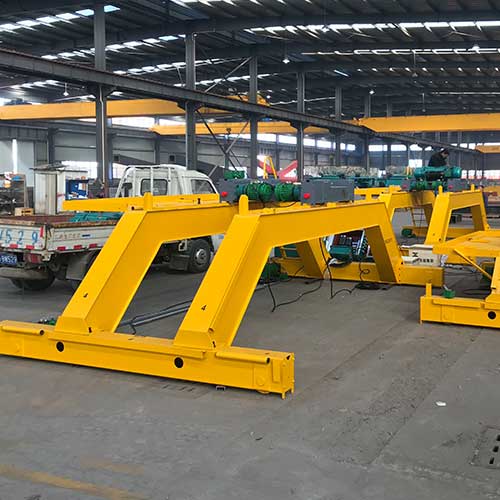
Portable bridge cranes offer a flexible and mobile solution for lifting tasks, allowing operators to move them easily from one location to another within a workshop.
Flexibility and Mobility Considerations:
- Ease of Setup: Portable cranes can be assembled and disassembled quickly, making them ideal for workshops with fluctuating needs.
- Space Efficiency: They require less permanent infrastructure, allowing for greater adaptability in smaller or shared spaces.
- Versatility: Ideal for smaller jobs or when specific lifting tasks vary from day to day, portable bridge cranes can be used for diverse applications, including maintenance tasks or temporary installations.
Typical Applications: These cranes are well-suited for small machine shops, repair facilities, and construction sites where mobility is essential, enabling users to lift items such as equipment, tools, and components across various locations. Check the customized portable overhead crane 5 ton for pipe handling, 10 ton portable gantry crane for sale Netherlands, etc.
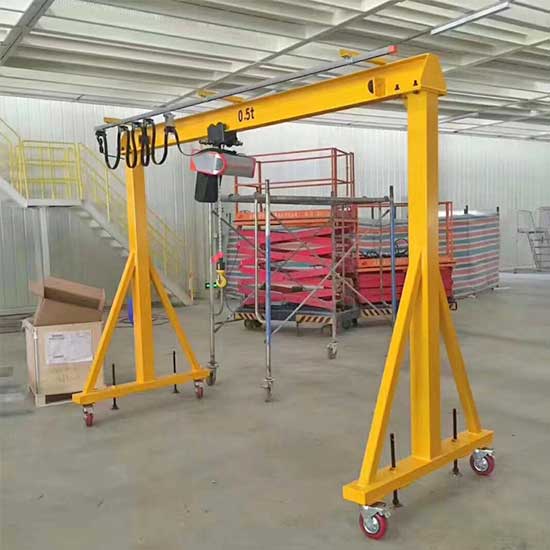
Custom bridge cranes are tailored solutions designed to meet the unique needs of specific workshops or operations.
Tailored Solutions:
- Specific Load Requirements: Custom cranes can be designed to handle particular weight capacities that may not fit standard models, ensuring safety and efficiency.
- Unique Dimensions: They can be built to fit specific workspace dimensions, accommodating irregular layouts or overhead obstacles.
- Special Features: Customizations can include specialized hoists, control systems, and safety features tailored to the specific environment or application.
Typical Applications: Custom bridge cranes are often used in specialized industries such as aerospace, automotive, and heavy equipment manufacturing, where unique lifting requirements must be met. By providing a tailored solution, these cranes enhance operational efficiency and safety, ensuring that they are perfectly suited for the tasks at hand. Check small shop bridge crane 5 ton for Saudi Arabia with customized runway for small workshop applications.
Evaluating Your Workshop Needs
Space Assessment
Before investing in a small shop bridge crane, conducting a thorough space assessment is crucial. This involves measuring the available space to ensure that the crane can be installed and operated effectively without interfering with other equipment or workflows.
How to Measure Available Space:
- Determine the Area: Identify the specific area in your workshop where the crane will be installed. Measure the length, width, and height of the space to determine if it can accommodate the crane's dimensions.
- Consider Ceiling Height: Measure the height of the ceiling to ensure sufficient clearance for the crane's lift height and the loads being lifted. Keep in mind any overhead obstacles, such as lights or ducts, that may restrict movement.
- Identify Support Structures: If applicable, measure the distance between support columns or walls that will affect the span of the crane. This will help determine which type of crane (single or double girder) is most suitable for your layout.
- Account for Movement Space: Ensure there is enough room around the crane for safe operation, including space for operators to move and access loads. Leave extra space for any additional equipment that may be used in conjunction with the crane.
By carefully assessing your available space, you can select a bridge crane that fits seamlessly into your workshop, maximizing efficiency and safety.
Workflow Considerations
Analyzing your workflow considerations is essential to understand how a small shop bridge crane can enhance efficiency in your workshop. This involves evaluating how materials and tools move within the space and identifying opportunities for improvement.
Analyzing the Movement of Materials and Tools:
- Map Current Workflow: Create a diagram of your workshop layout, noting the locations of workstations, storage areas, and equipment. Document how materials currently flow through these areas.
- Identify Bottlenecks: Look for areas where material movement slows down or becomes inefficient. Consider factors such as excessive manual lifting, time spent retrieving items, or obstacles that disrupt flow.
- Determine Lifting Needs: Identify which materials or tools require lifting and how often they are moved. This will help determine the crane's load capacity and frequency of use.
- Consider Integration with Other Equipment: Evaluate how the crane will interact with other machines or tools in your workshop. Ensure it can complement existing processes and improve overall efficiency.
By thoroughly analyzing your workflow, you can select a bridge crane that enhances productivity and helps streamline operations.
Budget Constraints
Setting a budget is a fundamental aspect of evaluating your workshop needs when purchasing a small shop bridge crane. Understanding the cost implications of different options can help you make an informed decision that aligns with your financial resources.
Setting a Budget and Understanding Cost Implications:
- Initial Costs: Consider the upfront cost of the crane, including any additional expenses for installation and setup. Research various models and brands to find options that fit your budget.
- Operating Costs: Account for the ongoing costs associated with the crane, such as electricity (for electric cranes), maintenance, and potential repair needs over time. Cheaper models may require more frequent maintenance or have shorter lifespans.
- Customization Options: If you're considering a custom bridge crane, evaluate how customization will impact the overall cost. Tailored solutions can be more expensive, but they may provide significant efficiency benefits in the long run.
- Financing Options: Explore financing options or payment plans that may be available, which can help spread the costs over time. This can make higher-quality cranes more accessible without straining your budget.
By setting a realistic budget and understanding the financial implications of your choices, you can make a purchase that not only meets your operational needs but also aligns with your financial capabilities.
Maintenance Requirements
Regular maintenance is essential to keep your small shop bridge crane operating efficiently and safely. Establishing a maintenance routine can prevent costly repairs and extend the crane's lifespan.
Routine Checks and Maintenance Practices to Ensure Longevity:
- Daily Inspections: Before each use, conduct a quick visual inspection of the crane. Check for signs of wear, loose components, and any unusual noises during operation.
- Lubrication: Keep moving parts, such as wheels and hoist mechanisms, well-lubricated to minimize friction and prevent wear. Refer to the manufacturer's guidelines for the recommended lubrication schedule and types of lubricants to use.
- Load Testing: Periodically perform load tests to ensure the crane can handle its rated capacity. This is particularly important after any repairs or modifications.
- Safety Feature Checks: Regularly test safety features, such as limit switches and emergency stops, to ensure they function correctly. Address any malfunctions immediately.
- Structural Integrity: Inspect support structures and connections regularly for signs of corrosion, fatigue, or structural weakness. Address any issues promptly to maintain safety and performance.
- Documentation: Maintain a maintenance log that records all inspections, repairs, and parts replacements. This documentation can help track the crane's condition and assist with future maintenance planning.
By adhering to these maintenance requirements, you can significantly enhance the performance and safety of your small shop bridge crane.
Manufacturer Considerations
Reputation and Experience
When selecting a small shop bridge crane, choosing a manufacturer with a strong reputation and experience is essential. A reputable manufacturer ensures quality, safety, and reliability in their products, which are critical factors for effective crane operation.
Importance of Selecting a Reputable Manufacturer:
- Quality Assurance: Established manufacturers typically adhere to industry standards and regulations, which means their cranes are likely to be built with high-quality materials and craftsmanship. This reduces the risk of malfunctions and increases the lifespan of the equipment.
- Track Record: A manufacturer with years of experience is more likely to have a proven track record of producing reliable equipment. Researching customer reviews and testimonials can provide insights into the manufacturer's performance and the satisfaction of previous buyers.
- Innovation: Experienced manufacturers are often more adept at incorporating the latest technology and design innovations into their cranes. This can lead to improved functionality, efficiency, and safety features.
- Industry Specialization: Some manufacturers specialize in specific industries or types of cranes. Choosing one that understands the unique needs of your workshop environment can lead to better product recommendations and solutions tailored to your requirements.
By selecting a manufacturer with a solid reputation and extensive experience, you can have confidence in the quality and reliability of your small shop bridge crane.
Warranty and Support
Understanding the warranty and support offered by a manufacturer is crucial when investing in a small shop bridge crane. A comprehensive warranty and responsive customer support can save you time and money in the long run.
What to Look for in Terms of Warranty and Customer Support Services:
- Warranty Coverage: Look for a manufacturer that provides a clear and comprehensive warranty on their cranes. A good warranty should cover defects in materials and workmanship for a reasonable duration. Pay attention to the specific components covered, such as the hoist, motor, and structural elements.
- Customer Support Services: Evaluate the level of customer support the manufacturer offers. This includes access to technical support, troubleshooting assistance, and availability of replacement parts. A manufacturer with responsive customer service can help address any issues that arise during operation.
- Maintenance Support: Some manufacturers provide maintenance programs or resources to help you keep your crane in top condition. This can include scheduled maintenance services, training for your staff, or guides on best practices for operation and upkeep.
- Installation Assistance: Consider whether the manufacturer offers installation support or guidance. Some manufacturers may provide on-site assistance or detailed manuals to ensure proper setup, which can be particularly beneficial for first-time users.
By prioritizing manufacturers that offer strong warranty options and reliable customer support, you can enhance the safety and efficiency of your small shop bridge crane, ultimately leading to a more successful operation in your workshop.
Regulatory Compliance
Understanding Safety Standards
When operating a small shop bridge crane, understanding and adhering to safety standards is crucial for ensuring a safe working environment. Various regulations and certifications govern crane operations, and familiarizing yourself with these can help protect your employees and your investment.
Overview of Relevant Safety Regulations and Certifications:
- OSHA Standards: The Occupational Safety and Health Administration (OSHA) sets forth regulations that govern workplace safety in the United States. Familiarize yourself with OSHA guidelines specific to crane operation, as these outline essential safety practices, training requirements, and operational protocols.
- ANSI Standards: The American National Standards Institute (ANSI) provides standards related to crane design and operation. These standards help ensure that cranes are safe and reliable. Look for ANSI certifications when selecting a bridge crane, as they indicate compliance with industry benchmarks.
- ISO Certifications: The International Organization for Standardization (ISO) offers global safety standards applicable to crane manufacturing and operation. ISO-certified manufacturers meet stringent quality and safety requirements, enhancing the reliability of their products.
- Local Regulations: In addition to federal standards, check for any local or state regulations that may apply to crane operations in your area. Compliance with these regulations is essential for legal operation and may involve obtaining necessary permits or inspections.
By ensuring that your small shop bridge crane meets all relevant safety standards and certifications, you create a safer workplace and reduce the risk of accidents and liabilities.
Installation Compliance
Ensuring that your crane installation complies with local and industry-specific guidelines is vital for safety and operational efficiency. Proper installation not only adheres to regulatory requirements but also enhances the crane's performance and longevity.
Ensuring Your Crane Meets Local and Industry-Specific Installation Guidelines:
- Local Building Codes: Before installation, consult local building codes to confirm that your crane setup complies with zoning and structural requirements. These codes dictate aspects such as load capacities, structural integrity, and safety measures that must be in place.
- Manufacturer Guidelines: Follow the installation instructions provided by the crane manufacturer. These guidelines are designed to ensure that the crane operates safely and efficiently within its specified parameters. Deviating from these instructions can lead to safety hazards and void warranties.
- Professional Inspection: Consider hiring a professional engineer or crane specialist to inspect the installation site and oversee the installation process. Their expertise can help identify any potential issues related to structural support, electrical connections, or compliance with safety standards.
- Regular Inspections: After installation, conduct regular inspections to verify that the crane remains compliant with safety regulations and operational guidelines. This includes checking for any wear or damage to the crane and ensuring that it continues to meet load and safety requirements.
By adhering to installation compliance guidelines, you not only enhance the safety of your small shop bridge crane but also contribute to its optimal performance and reliability in your workshop.
Conclusion
In conclusion, selecting the right small shop bridge crane is a critical decision that can significantly impact the efficiency and safety of your workshop operations. With various types, features, and compliance requirements to consider, a careful and informed approach to purchasing is essential. Remember, taking the time to evaluate your specific needs—such as load capacity, available space, and workflow considerations—will help ensure that you choose a crane that meets your operational demands.
Moreover, consulting with industry experts or manufacturers can provide valuable insights and guidance tailored to your workshop environment. Their expertise can assist you in navigating the complexities of crane selection, installation, and compliance with safety standards.
By prioritizing these factors, you will not only enhance the safety and productivity of your workshop but also protect your investment in this essential equipment.
Related Products

Latest project
150 Ton Overhead Crane Installation Feedback – Paraguay Case
QDX 150 ton overhead crane in action in Paraguay. Installation photos, video, and client feedback show performance, safety, and heavy-lifting efficiency.
Free consultation to Confirm Parameters & Specifications and Get
Latest Crane Price & Crane Rate.
- Types of overhead cranes : _______?
- Optional: Overhead travelling crane, goliath gantry crane,Slewing jib crane, Single girder or double girder crane,small portable crane or kbk crane, etc.
- Capacity of overhead crane: _______?
- Optional: 0.25ton, 0.5 ton, 1 ton, 2 ton, 3ton, 5 ton, 10 ton,15ton, 20ton, 25 ton, 30ton,35ton, up to 550ton, etc.
- Crane span & lifting height : _______?
- Crane travelling length : _____?
- Control of overhead crane:_______?
- Optional: pendant/ remote/cabin control
- Voltage supply of overhead crane:_____?
- Eg,: 380V50/60HZ,3Phase or others,etc.
- Application/usage of crane:_______?
- Eg,: Steel mill, ,injection mold, cement,stone, concrete,granite, general manufacturing, etc.
Just leave a message via the contact form and our hoist and crane engineer will contact you with in 24working hours.
Get In Touch
